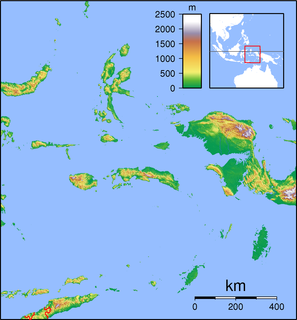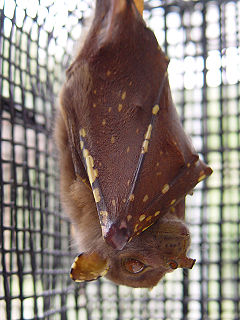
Bandicoots are a group of more than 20 species of small to medium-sized, terrestrial, largely nocturnal marsupial omnivores in the order Peramelemorphia. They are endemic to the Australia–New Guinea region, including the Bismarck Archipelago to the east and Seram and Halmahera to the west.

The common echymipera, or common spiny bandicoot, is a bandicoot. It is long-snouted even by bandicoot standards. The upper parts are a coarse reddish brown, flecked with spiny buff and black hairs. The tail is short and almost hairless. Length varies between 300 and 400 mm, with the tail accounting for an additional 80 to 100 mm; weight is from 600 to 2000 g.

The marsupial family Peramelidae contains all of the extant bandicoots. They are found throughout Australia and New Guinea, with at least some species living in every available habitat, from rainforest to desert. Four fossil peramelids are described. One known extinct species of bandicoot, the pig-footed bandicoot, was so different from the other species, it was recently moved into its own family.

The Trobriand Islands rain forests are a tropical moist broadleaf forest ecoregion of southeastern Papua New Guinea.

Batanta is one of the four major islands in the Raja Ampat Islands in West Papua province, Indonesia. Its area is 453 km² and its highest point is 1184 m. The Pitt Strait separates it from Salawati, while the Dampier Strait separates it from Waigeo.

The flute-nosed bat is a vespertilionid bat with an unusually shaped nose, the tubular nostrils facing outward from the end of the muzzle. They occur in the north of the Australian state of Queensland, in Indonesia, and on Papua New Guinea.

Clara's echymipera, or Clara's spiny bandicoot or white-lipped bandicoot, is a species of marsupial in the family Peramelidae. It is found in West Papua, Indonesia and Papua New Guinea. Its natural habitat is subtropical or tropical dry forests. It is threatened by habitat loss.

David's echymipera, or David's spiny bandicoot, is a species of marsupial in the family Peramelidae. It is found on the island of Kiriwina, in the Trobriand Islands of Papua New Guinea, and may be present on other nearby islands also.

The long-nosed echymipera, or long-nosed spiny bandicoot, is a species of marsupial in the family Peramelidae. It is found in Australia, Indonesia, and Papua New Guinea. Its natural habitat is subtropical or tropical dry forests.

The dusky leaf-nosed bat is a bat from the genus Hipposideros whose habitat extends from India and Sri Lanka to the Philippines, New Guinea and Northern Australia. This species is counted in the H. bicolor species group and was formerly classified within that species.

The common tube-nosed fruit bat is a species of megabat in the family Pteropodidae. It is found at islands north of Australia, and in Indonesia, Papua New Guinea, the Philippines and the Solomon Islands.

The demonic tube-nosed fruit bat is a species of bat in the family Pteropodidae. It is endemic to Papua New Guinea. The holotype specimen was collected in 1979 on New Ireland, in the Bismarck Archipelago. It was described as a new species in 1983. The range of the species may extend to other islands, however the extent of the range is not presently known.

Nyctimene is a genus of bats in the Pteropodidae family. Commonly known as tube-nosed fruit bats, they are found in the central Philippines, eastern Indonesia, Papua New Guinea and the north-east coast of Australia.

Ficus variegata is a well distributed species of tropical fig tree. It occurs in many parts of Asia, islands of the Pacific and as far south east as Australia. There is a large variety of local common names including common red stem fig, green fruited fig and variegated fig. A non strangling fig which may reach 30 metres in height. The tree is evergreen when young but becomes briefly deciduous as it grows older. In Australia the fruit are eaten by cassowaries and double-eyed fig parrots.
The long-nosed paramelomys is a species of rodent of the family Muridae endemic to New Guinea. It is found in the lowlands of the south of the country.












